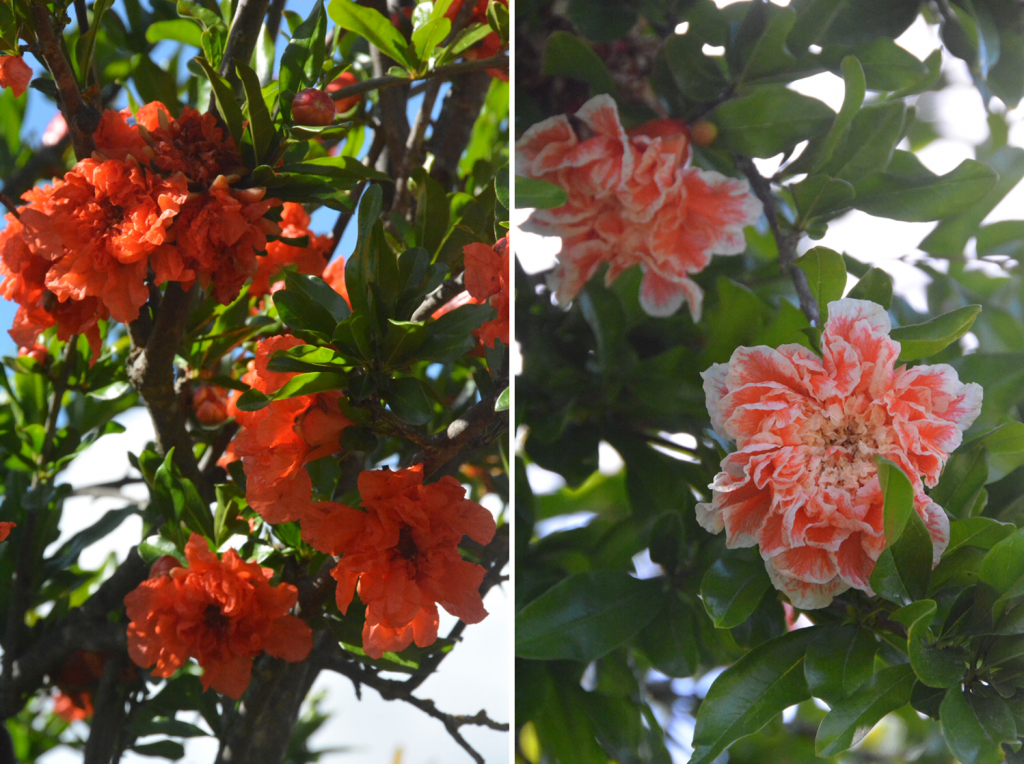Pomegranate Collection
Jeff Moersfelder, USDA-ARS National Clonal Germplasm Repository, One Shields Drive, University of California, Davis, California 95616
Gayle M. Volk, USDA-ARS National Laboratory for Genetic Resources Preservation, 1111 S. Mason St., Fort Collins, Colorado 80521
Emma Balunek, USDA-ARS National Laboratory for Genetic Resources Preservation, 1111 S. Mason St., Fort Collins, Colorado 80521
John E. Preece, USDA-ARS National Clonal Germplasm Repository, One Shields Drive, University of California, Davis, California 95616
Outline
1. Introduction
The Punicaceae family has only one genus and two species. The cultivated species Punica granatum is native to Iran and the Himalayas, and is of economic importance. The second species, Punica protopuncia, is native to the island of Socotra, which is off the coast of Yemen in the Arabian Sea (Marzolo, 2015); it is not economically important. Pomegranates (Punica) are small trees or large shrubs that stand 20 to 30 feet high and have thorns on their branches. The plants produce many suckers from the base of the plant that require annual pruning to make the plant tree-like.
The edible parts of pomegranates are the arils that are the juicy coating around the seed. The entire seed can be consumed. Juice is another popular way to consume pomegranates (Marzolo, 2015). Pomegranates are considered a “superfood” due to high amounts of antioxidants, anti-inflammatory properties, vitamins, potassium, folic acid, and iron (Breuner et al., 2019).
In 2012, the United States grew pomegranates on 32,887 acres. California produces over 90% of pomegranates grown in the United States and in 2012 there were 26,935 acres yielding pomegranates. California’s pomegranates were valued at $115.4 million in 2012 (Marzolo, 2015).
2. punica (pomegranate) collection
The U.S. National Plant Germplasm System pomegranate collection has 192 accessions of Punica granata that are maintained as trees in the field. The pomegranate collection includes varieties that are cultivated for their fruit, which can be white, pink, red, or purple. It also has ornamental pomegranates valued for their flowers from Japan.
Figure 1. Pomegranate trees in the U.S. National Plant Germplasm System pomegranate collection (left) and pomegranate fruit on a tree (right). Photo credit: Gayle Volk (left), USDA Image Gallery (right).
Figure 2. Flowers of cultivated pomegranate grown for its fruit. Photo credit: Gayle Volk.
Figure 3. Flowers of ornamental pomegranates in the U.S. National Plant Germplasm System pomegranate collection. Photo credit: Gayle Volk.
Figure 4. Pomegranate fruit in the U.S. National Plant Germplasm System pomegranate collection showing diversity in aril colors. Photo credit: USDA Image Gallery (left), Gayle Volk (right).
Video 1. Dr. John Preece discusses the pomegranate collection.
3. references
Breuner N, Gorgon C, Hanley K, Bunning M. 2019. Pomegranates. Food Source Information: Colorado Integrated Food Safety Center for Excellence. https://fsi.colostate.edu/pomegranates/
Marzolo G. 2015. Pomegranates. Agricultural Marketing Resource Center. https://www.agmrc.org/commodities-products/fruits/pomegranates
4. additional information
Curator: Jeff Moersfelder, USDA-ARS National Clonal Germplasm Repository, One Shields Drive, University of California, Davis, CA 95616-8607, jeff.moersfelder@usda.gov
5. Acknowledgments
Citation: Moersfelder J, Volk GM, Balunek E, Preece JE. 2021. Pomegranate collection. In: Volk GM, Preece JE (Ed.) Field tour of the USDA National Clonal Germplasm Repository for Tree Fruit, Nut Crops, and Grapes in Davis, California. Fort Collins, Colorado: Colorado State University. Date accessed. Available from: https://colostate.pressbooks.pub/davisrepositoryfieldtour/chapter/pomegranates/
This training module was made possible in part by funding from USDA-ARS, Colorado State University, and the United States Agency for International Development (USAID).
Editors: Emma Balunek, Gayle Volk, Katheryn Chen
This project was funded in part by the National Academy of Sciences (NAS) and USAID, and any opinions, findings, conclusions, or recommendations expressed in such are those of the authors alone, and do not necessarily reflect the views of USAID or NAS. USDA is an equal opportunity provider and employer. Mention of trade names or commercial products in this article is solely for the purpose of providing specific information and does not imply recommendation or endorsement by the US Department of Agriculture.






